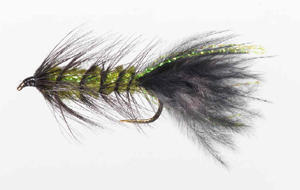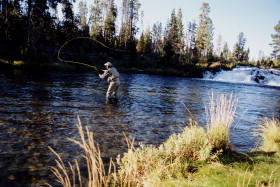Of all the myriad of fresh water patterns, the Woolly Bugger ranks high among the best all time trout producers. Much of the Woolly Buggers success is due to its "buggyness", and when fished correctly the "Bugger" breathes life imitating an assortment of food organisms including leeches, forage fish, crayfish, stoneflies, and hellgrammites. One of the outstanding attributes of this fly is the universal diversity on still-waters (lakes), freestone rivers, and tail-water fisheries. The majority of serious anglers simply refer to the Woolly Bugger as "The Bugger."

Raymond Blessing invented the Woolly Bugger back in 1967. Blessing, a resident of Lancaster Pennsylvania, originally tied the Woolly Bugger with a black tail, black hackle, and olive body for his "home" river the Little Lehigh. The fly was designed to specifically imitate hellgrammites and was inspired by another "eastern" pattern called the Blossom Fly. Blessing's daughter, Judy, named the fly, and as they say, the rest is history.
Today Woolly Buggers are tied in a variety of colors, styles, and sizes suitable for many different fishing applications. Some of these include Bead Head Woolly Buggers, Cone Head Woolly Buggers, Flash-A-Buggers (crystal flash is tied in the body and tail), Egg-Sucking Leeches (Woolly Bugger with an egg-fly tied in the front), in purple, black, brown, and olive. Whatever style you opt to fish, you'll appreciate the productivity of this great trout fly.
Woolly Buggers, or any other streamer for that matter, fish best on overcast days, early mornings (dawn), and just prior to sun-set (dusk). During these low light conditions both trout and the forage fish are a little more at ease. Traditionally, streamer fishing accounts for less than 10% of your total angling time, however during certain key periods they can be deadly! Spring and fall are a great time of the year to fish "Buggers" because spawning fish become very territorial and much more aggressive than normal.

When fishing your Woolly Bugger use a 4 foot 3X tapered leader. If you choose to fish with anything less than 3X you'll likely break off several flies. Another disadvantage to a longer and thinner leader is the challenge of turning over the fly. Depending on how deep the river or lake is, additional weight or a sink tip line may be required. For most situations a #4 split shot works well placed right in front of the eye of the hook.
When fishing streams you may dead drift this pattern or impart action by stripping the fly. Successful streamer fishing starts by showing the fly to as many fish a possible. Deliver the fly down stream at a 45 degree angle and as close to the bank as possible. Most of the forage fish live very close to the bank. Immediately lower the rod tip to the water (this technique keeps the fly line tight with no slack!) and place the fly line under your index finger (your line management tool) and begin striping the fly. I prefer an 8-12 inch strip on streams, however find what works best for you. Forage fish swim fast, and dart around especially when they are being chased. Leeches on the other hand swim very slowly. Methodically work your way downstream. It is not effective to fish the same water over and over with streamers. More than likely you'll get a strike in the first three to four strips, and believe me there will be no doubt the fish hit your streamer. When you feel the strike simply lift the tip, get the fish on the reel and play it masterfully to the net.
When fishing lakes I prefer a float tube and sinking line. There are many different sink tip lines available depending on the time of the year, water temperature, and depth of the lake you are fishing. Fishing from the bank is also very effective much of the year. Preferably use a 4 foot tapered leader terminating in 3x. Often times trailing a smaller fly (i.e. small bead heads, hare's ears, pheasant tails, midge pupa) off the bend of the "bugger" on still water fisheries in very beneficial. Ideally strip the streamer slower on lakes than on streams. Again find a style that works well for you, or vary the strips so that you imitate a number of the food organisms. Methodically cover the lake searching for fish. Unlike rivers, trout on constantly on the prowl looking for their food. For best results fish around the drop offs, weed beds, and inlet to the lake.
The autumn season is in full swing and fishing should remain outstanding till the middle of November. Tricos mayflies are winding down and the blue wing olives are beginning to hatch every day in the early afternoon. Eager trout sip these tiny adult mayflies with a vengeance as they prepare for the change of season. Brown trout sport their brilliant colors in preparation to spawn. The nights are cool and crisp, and the days are mild. All of these signs are Mother Natures way of telling us the season is coming to a close. Take advantage of this great time of year while you can, time is very precious.
 Raymond Blessing invented the Woolly Bugger back in 1967. Blessing, a resident of Lancaster Pennsylvania, originally tied the Woolly Bugger with a black tail, black hackle, and olive body for his "home" river the Little Lehigh. The fly was designed to specifically imitate hellgrammites and was inspired by another "eastern" pattern called the Blossom Fly. Blessing's daughter, Judy, named the fly, and as they say, the rest is history.
Raymond Blessing invented the Woolly Bugger back in 1967. Blessing, a resident of Lancaster Pennsylvania, originally tied the Woolly Bugger with a black tail, black hackle, and olive body for his "home" river the Little Lehigh. The fly was designed to specifically imitate hellgrammites and was inspired by another "eastern" pattern called the Blossom Fly. Blessing's daughter, Judy, named the fly, and as they say, the rest is history.
 When fishing your Woolly Bugger use a 4 foot 3X tapered leader. If you choose to fish with anything less than 3X you'll likely break off several flies. Another disadvantage to a longer and thinner leader is the challenge of turning over the fly. Depending on how deep the river or lake is, additional weight or a sink tip line may be required. For most situations a #4 split shot works well placed right in front of the eye of the hook.
When fishing your Woolly Bugger use a 4 foot 3X tapered leader. If you choose to fish with anything less than 3X you'll likely break off several flies. Another disadvantage to a longer and thinner leader is the challenge of turning over the fly. Depending on how deep the river or lake is, additional weight or a sink tip line may be required. For most situations a #4 split shot works well placed right in front of the eye of the hook.


